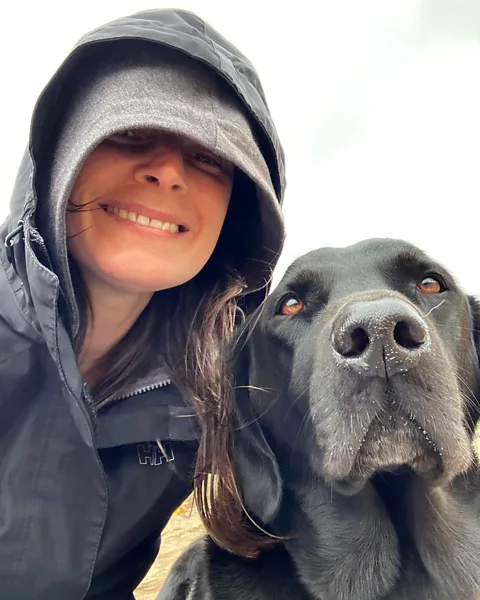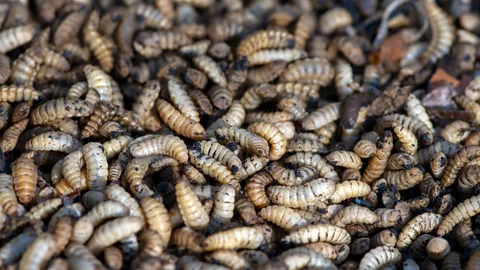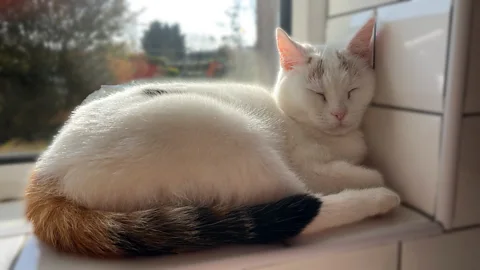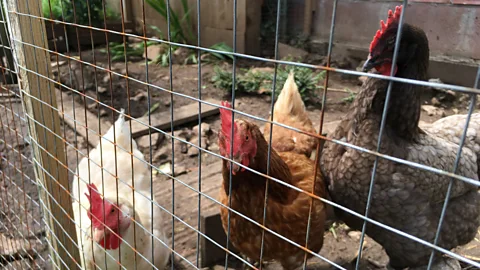How I made my pets more environmentally friendly
 Katherine Latham
Katherine LathamPets may be beloved members of the family – but research shows their upkeep can have a significant impact on the environment. Is it impossible to reduce their carbon paw print?
Lying on the living room floor, our enormous black Labrador Barney closes his eyes in bliss, never happier than when surrounded by the chaos of family life. Barney is a gentle giant – not far off the size of a Shetland pony – and often finds himself at the bottom of a "puppy pile" underneath our three children, Billy (10), Sammy (8) and Sophie (3). And when he's not snoozing he's either zooming about the garden like a loon or bounding through muddy fields with me as we train for our next trail run. Barney's other great pleasure in life is food – and a five-year-old, 33kg (73lb), active dog like Barney has quite an appetite – getting through around 2kg (4.4lb) of dry dog food every week.
Barney is one of six animals that live with us, alongside our cat Sookie, and four chickens. Sookie is a 13-year-old rescue moggie. She terrorises the dog, refuses to come in at night, then turns up in the morning covered in scratches. She is one hardy old lady. The chickens, meanwhile, are peaceful animals, happy scratching about in the mud, or snuggling in the coop.
 Katherine Latham
Katherine LathamPets may be beloved members of the family – but research shows they can have a significant impact on the environment. I am constantly aware of my own environmental impact and this influences my choices. But when it comes to my pets, this isn't a thought at the forefront of my mind. So, how can I keep my animals in a more sustainable way?
I decided to take a look at each of my animals' diets and accessories to see if I could switch anything out to make my pets less of a burden on the environment.
Global pet populations are on the rise, with likely over a billion worldwide. The most popular is man's best friend – with almost 70 million dogs in the United States alone. That's a lot of poo bags, squeaky toys and food.
Roughly 35 million tonnes of dry pet food was produced around the world last year. Of this an estimated 5.9 million tonnes of dry pet food is given to cats while dogs consume around 20.8 million tonnes.
Both dogs and cats eat meat. Compared to a plant-based diet, meat requires more energy, land and water to produce, and has greater environmental consequences in terms of erosion, pesticides and waste. University of California Los Angeles (UCLA) researchers calculated that meat-eating by dogs and cats in the US alone creates the equivalent of about 64 million tonnes of carbon dioxide (CO2) a year – roughly the same climate impact as driving 12.5 million cars for a whole year. Another paper by researchers at the University of Edinburgh also calculated that every year an area double the size of the UK is needed to produce dry food for the world's cats and dogs.
Sign up to Future Earth
Sign up to the Future Earth newsletter to get essential climate news and hopeful developments in your inbox every Tuesday from Carl Nasman. This email is currently available to non-UK readers. In the UK? Sign up for newsletters here.
Peter Alexander, an expert in global food security at the University of Edinburgh in Scotland, describes what he sees as an "extremely negative" trend towards the humanisation of pet food. "Pet owners are buying human grade meat or higher quantities of meat. If it's got more animal product in it, it's going have higher associated emissions," he says. And it's very difficult to know exactly what's in many pet foods, he adds. "Even when you have an ingredient list, it often doesn't tell you the percentages. It's impossible for consumers to really get any insight into what it is they're buying and what the environmental impact is."
So, switching to more sustainable feed alternatives with traceable, measurable ingredients could reduce the environmental impact of my pets.
The dog
According to experts from Maastricht University in the Netherlands, an average size dog might be responsible for emitting over 19 tonnes of CO2 in its lifetime, equivalent to driving a car for around 50,000 miles (80,470 km) – or more than twice around the circumference of the Earth.
Lamb and beef production are by far the most resource-intensive proteins and emit roughly four times the amount of CO2 as other foods, including pork, poultry and fish. So, choosing my dog's protein carefully seems like a no-brainer.
An alternative protein gaining traction in the pet food industry comes from insects. Insects can be fed food waste, and have a high feed-to-meat conversion rate. Plus, they take up much less land. According to US-based insect pet food company Jiminy's, if you had one acre of land with cows on it, after one year you could produce 192lb (87kg) of protein – but with grubs, you could produce over 1,000,000lb (453,600kg) of protein. (Read more about why insects are a neglected, protein-rich "superfood".)
Jiminy's founder, Anne Carlson had worked in the consumer packaged goods industry for many years – but a conversation with her daughter inspired her to go it alone.
"My daughter told me that she didn't want to have kids," says Carlson. "She was worried about what the world would be like by the time they grew up. She was talking about climate change."
In that moment, Carlson realised she had to act. "My pivot was to sustainability and pets – because dogs eat the same thing every day. If you swap it with a sustainable alternative, you get all of their eating occasions, so you can have massive impact."
So, in 2016, Carlson set up Jiminy's, offering dog food made of crickets and black soldier fly larvae.
"The grubs are incredible eating machines," she says. "They can pretty much eat anything. And [our suppliers] are starting to use pre-consumer byproducts to feed them. A lot of our grubs come from Kentucky, where there is a bourbon manufacturer – they're pulling the spent grains, the stillage, which is the liquid that's left, and feeding that to the grubs. So, they're very versatile."
Jiminy's uses the whole bug, which is roasted and ground. "So, no waste there," says Carlson. What is left over when the bugs are harvested is the faeces, or "frass", she says. "This is an incredible fertiliser." This insect waste also shows potential as an agricultural animal feed.
Plus, she says, insects are very nutritious, containing all the essential proteins, fats, minerals and amino acids a dog needs.
 Alamy
AlamyBarney currently eats fish protein and – according to Jiminiy's own calculator – I could reduce his yearly greenhouse gas emission by 112kg (247lb) by switching to insects, equivalent to driving a car for around 315 miles. But all ready to make the switch, I came across a report that warns of insect foods possibly causing allergic reactions in animals that have existing allergies to insects, such as dust mites and storage mites – which Barney does.
So, what about a plant-based diet for Barney?
"Environmentally, it's the same story as for a human diet," says Alexander. "Typically plant-based foods will have a lower impact than animal-based products. This is particularly true for pet foods as often they won't use the more environmentally burdensome foods – as these tend to be higher value."
You might also like:
Dogs are omnivores so, much like us humans, you might think it would be fairly simple to swap out meat proteins for plant ones. However, according to the British Veterinary Association, the jury is still out on whether a vegan diet can meet all the nutritional needs of a dog. A 2020 report found that commercially available vegan dog food did not have the necessary nutrient levels, and could lead to dietary deficiencies. Conversely, a 2022 study found dogs on vegan diets suffered less health disorders than those on conventional or raw meat diets. But, as dog-veganism is a relatively new trend, it seems there simply isn't enough evidence one way or another.
Barney, however, has 17 allergies – including grasses, trees and weeds – and after discussing a possible diet change with his vet, we have decided to keep him on his fish-based hydrolysed dry food, specially formulated for dogs with allergies.
So, how else might we make him more environmentally friendly? He doesn't have plastic toys, or any toys, as we learnt early on that Barney eats everything. Poo bags on the other hand, we get through loads of. We use compostable bags which we send to landfill with the rest of our rubbish. However, Rachel Dobb, head of e-commerce at pet accessories firm Beco, says this is one of the worst things we could do.
Compostable bags, she says, can break down without releasing any harmful toxins within six months – but they must be disposed of in a well-managed compost heap for this to happen. Dog waste cannot simply be added to your typical garden compost heap.
CARBON COUNT
The emissions from travel it took to report this story were 0kg CO2. The digital emissions from this story are an estimated 1.2g to 3.6g CO2 per page view. Find out more about how we calculated this figure here.
"Landfill conditions lack moisture and oxygen, key components in breaking down waste," she says. "If these bags find themselves in landfill they will not break down."
Instead, Dobb recommends using bags made from recycled plastic as these bags have an 86% lower carbon footprint than virgin plastic. As a bonus, I found recycled bags were also half the price of compostable ones.
Other options would be to invest in a worm farm in which the faeces could be composted or – if you're lucky enough to live in the Malvern Hills in Gloucestershire, the UK – you could use one of the free paper dog poo bags that, when put in a bin, feed into a bio-digester and power biogas street lamps.
So, Barney's waste management needs a rethink. I don't feel comfortable home composting, with small children around; instead we'll make the switch to recycled plastic bags.
The cat
Pet cats can generate over three tonnes of CO2 in a lifetime. It would take 150 trees growing for a year absorb this. So, how can we make Sookie more environmentally friendly?
Let's take a look at cat litter. Both clay and silica cat litter are made from minerals strip mined from the Earth, an environmentally invasive process. Neither of these litters are biodegradable. Bio-based alternatives are becoming more readily available, made from sources such as corn, wheat and wood flakes. However, they still need manufacturing and transporting which inevitably generates emissions, although I couldn't find any solid data on this.
 Katherine Latham
Katherine LathamSookie doesn't use a litter tray and does her business outside. Cat waste could introduce harmful bacteria into local waterways – but with just one cat it's likely not an issue. However, her love of the outdoors has another negative impact.
Cats are opportunistic hunters. Their prey includes a wide range of animals – from birds to butterflies. In the UK, pet cats brought home 57 million mammals, 27 million birds, and five million reptiles and amphibians – and likely killed several times these numbers – all in just five months. Meanwhile in the United States, cats' predation tally runs into the billions – up to 4 billion birds, 22.3 billion mammals, 822 million reptiles and 299 million amphibians – making domestic cats the top source of human-related mortality for birds and small mammals in the country.
Some tactics to mitigate this include the use of cat bells and limiting pets' outdoor time. Some countries are encouraging or mandating keeping cats indoors to control their impact on wildlife. After getting Sookie a new bell and keeping her inside for the night, I'm not convinced it's made much of a difference. She hunts day and night, bringing us no end of mice, rats and birds.
 Alamy
AlamyFood-wise, cats are obligate carnivores. So, while a handful of studies have looked at the health outcomes of feeding cats a vegan diet, there is as yet insufficient evidence of whether this is a good idea. We decided the best option, therefore, was to move Sookie off of her fish-based food and onto an insect diet. We gradually mixed her usual fish flavoured dry food in with her new soldier fly-based kibble. At £12.99 ($15.95) per kilo, I was pleasantly surprised to find it only marginally more expensive than her standard food which costs £10.99 ($13.49) per kg. Another bonus of the insect food is that it is scentless – whereas Sookie's old food had quite a strong smell, not unlike the way it smelled post-digestion.
The chickens
We feed our girls mainly scraps from the kitchen, and as omnivores, this suits them. They'll eat anything – spaghetti is particularly funny. In doing so, they convert our food waste into eggs that don't need to be shipped across the country, helping reduce transport-related carbon emissions.
We do occasionally top our girls up with layers' pellets. And while chicken feed often contains soya, which has been linked to deforestation, this is largely associated with commercial poultry farming. What little chicken feed we give is soya-free and organic. It's made from all natural ingredients including wheat, maize, seaweed and marigold.
 Katherine Latham
Katherine LathamThe wood shavings we put in the coop are FSC approved – meaning they are made from wood from responsibly managed forests – but of course there will be emissions tied to the production and transportation. So, instead I tried a reusable egg-laying mat, a bit like a door mat with rubber bristles. However, on my first attempt to clean it, I found the chicken poo was so tangled in the mat it was impossible. That piece of plastic regrettably went in the bin. Another possibility is foraged bedding, made from dried leaves and grass – a fun way for the kids to be involved in caring for their animals.
Should we even keep pets?
We love our pets – but would the world be better off without them? Pets provide a range of therapeutic, physiological, psychological, and psychosocial benefits. They reduce stress, and give us company. In my family's case, I see our animals giving my children an appreciation of, and connection to nature. The chickens mean we have hardly any food waste at all, and the dog keeps us fit and gives us unwavering love.
It was disappointing that I couldn't change Barney's food – but perhaps, with all his allergies, he is not a typical dog. The shocking revelation that compostable poo bags are actually much worse for the environment mean a change to recycled plastic bags is a must, but it still feels wrong using so much plastic. Perhaps, when the children are older, I'll look into the worm farm option.
The cat on the other hand, while I'm fond of her (and don't tell my kids I said this), I could live without. I don't think we'll replace her when she goes. Despite the relative ease of changing her food and the lack of litter-associated environmental issues, in our family's case the cost to wildlife feels too much to bear.
The most surprising discovery I made during this experiment was that I do actually consider the environmental impact of my pets, without always realising I'm doing it. Although I'm far from perfect and acknowledge I have much to learn, perhaps the habit is so ingrained that it's made its way into my subconscious – and every part of my life.
If you liked this story, sign up for The Essential List newsletter – a handpicked selection of features, videos and can't-miss news delivered to your inbox every Friday.
